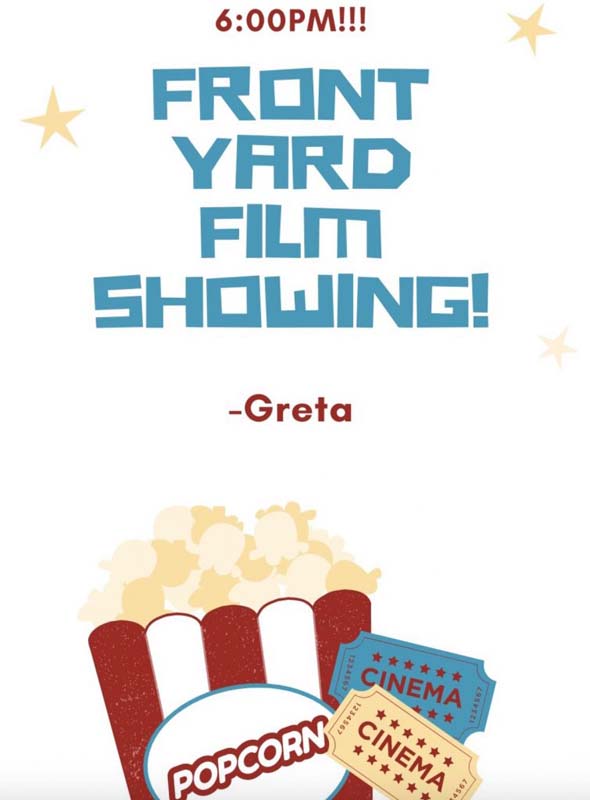For as long as I can remember (and even before that), I have loved to read. After a couple of years of being read to, and once I could start sounding out my own words, I loved to tell stories. I told true stories (sometimes exaggerated), stories I made up, stories I heard somewhere. Then, I started to write my own stories. The first real story I wrote was called “My Family” and I was super proud of it. Ever since then, I have been interested in creative writing and storytelling. This unit has given me a great opportunity to further my storytelling skills, visually, audibly, and in written form.
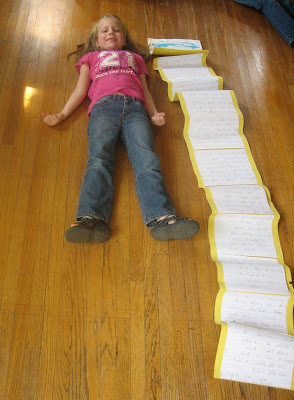
My first real story 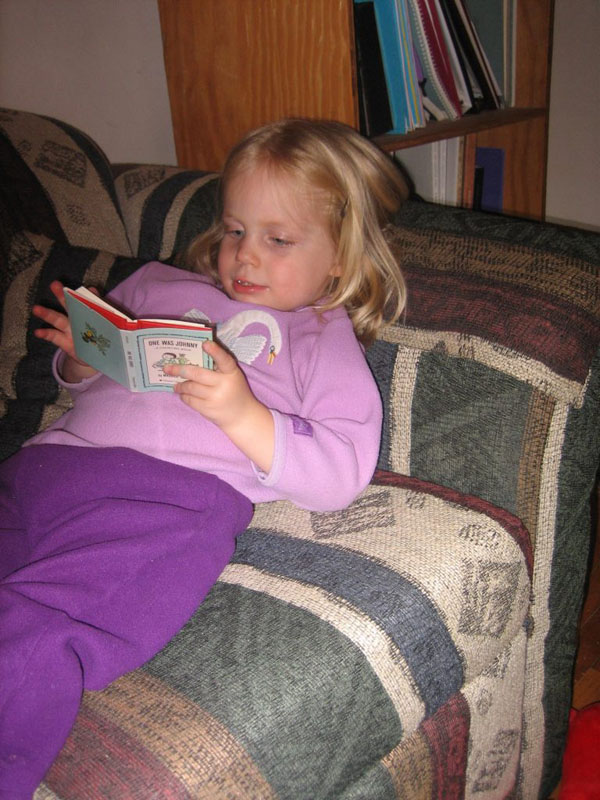
One was Johnny 
Books Make Me Happy
During the Visual Narrative Project unit, I worked in all three of my classes (English, Digital Media, and Film) to learn skills to be able to respond to the question, “How well can I visually tell a structured story?” I was able to experiment with different ways of telling a story. I loved how the skills and knowledge we learned in each class carried over into our other classes. The different aspects came together in the end to create a couple of satisfying final products. I am excited to get to share a look into the behind-the-scenes process with you today.

Sometimes, an idea for a story just pops into my head. Other times, I have to really think things through and get inspiration from somewhere unique. I was thrilled with the opportunities we had in English to draw inspiration from various places- artwork, songs, folktales, nature, and our passions. We were encouraged to explore a wide variety of ideas and work on one that we were passionate about. My first story’s inspiration came from an old fable, one of Aesop’s classics, The Old Hound.
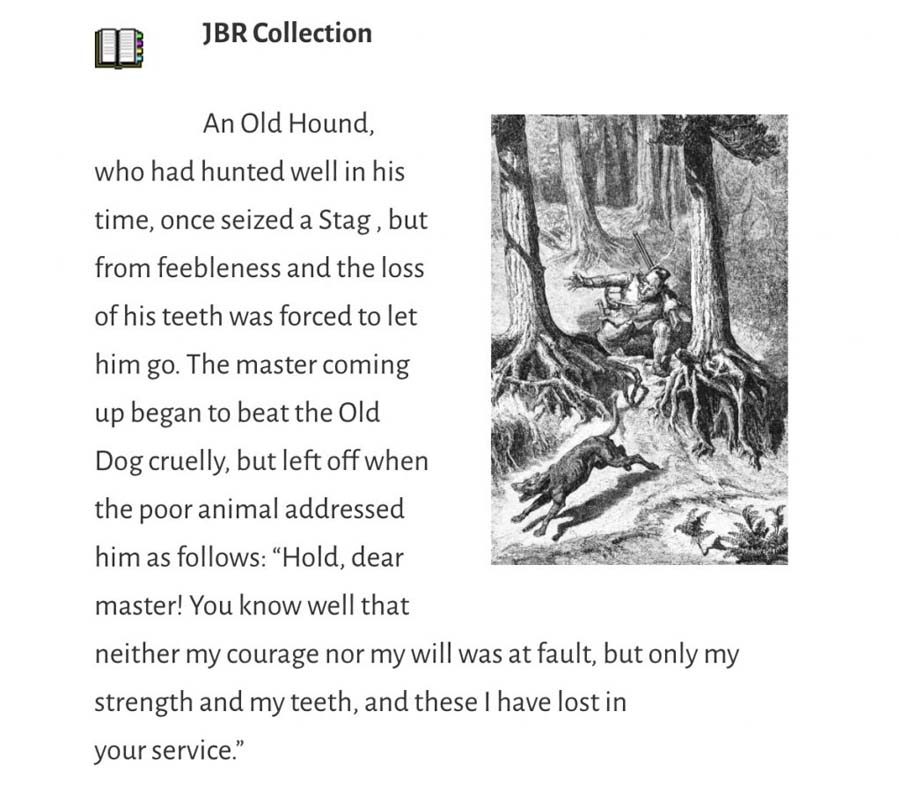
Reading this story made me sad, it did not seem to have a hopeful, motivating message like most fables I had heard in the past! “Slow and steady wins the race” or “Hard work pays off,” but I was not quite sure what the moral of this story was. Things like, “No matter how much you give they will never be satisfied” and “Once you are old, no one wants you,” floated around in my mind. Something about having such a dark moral bothered me, and I decided I wanted to write a story with the same moral at the beginning, but with a hopeful end.
We did many different exercises to try and get to know our characters that we would be writing about. We learned that even if an aspect of their life does not directly come up in our story, we, as the authors, should know the character well enough to know their whole story. This is key in making characters have meaningful motivations. One such assignment was answering a long list of interview questions, from our character’s point of view. Here are some example questions: “What is your most prized possession?” or “Who has let you down? Have you told them?” or “Did you have a happy childhood?” These kinds of questions forced us to really get to intimately know our characters.
Eventually, I knew that I wanted to write about: a mouse named Ricki (short for Ricotta) who was best friends with a sunflower. (Listen to my recording to get the full story!)
Another exercise we did once we had a rough idea for our story was a plot map. This helped us organize our ideas and visually see if our story followed a complete story arch. Here is my first draft of my map:
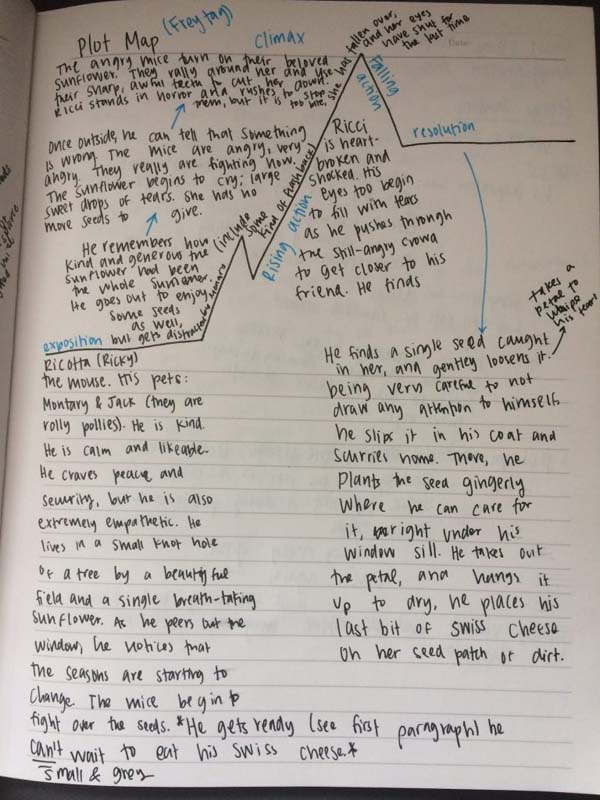
For the Audio recording of this story, I first read through the story a couple of times to practice different tones and to see what felt right. Even though this story has a “heavy” topic, I wrote it as a children’s story, so I wanted to make it sound like one. I then went through and found sound effects and music that I felt fit with the tone of my story, which was really fun. I enjoyed thinking about how sound effects can add a whole new layer to a story.
Here is a screenshot of what my ProTools workspace looked like:
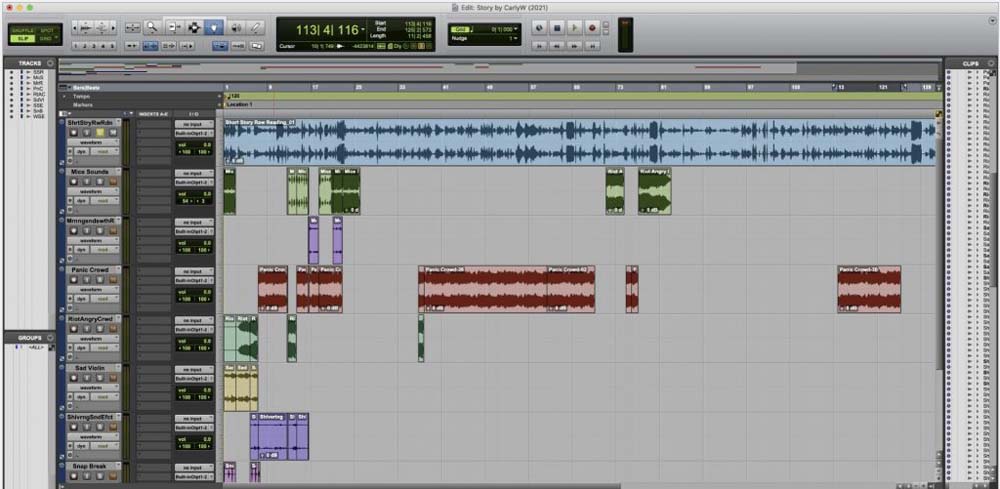
I had a lot of fun learning how to use Adobe Illustrator to make my album art. There were so many new tools that I was introduced to that made me able to do what I envisioned in my head! It was really rewarding to get to see it come to life.
Album Cover Art:
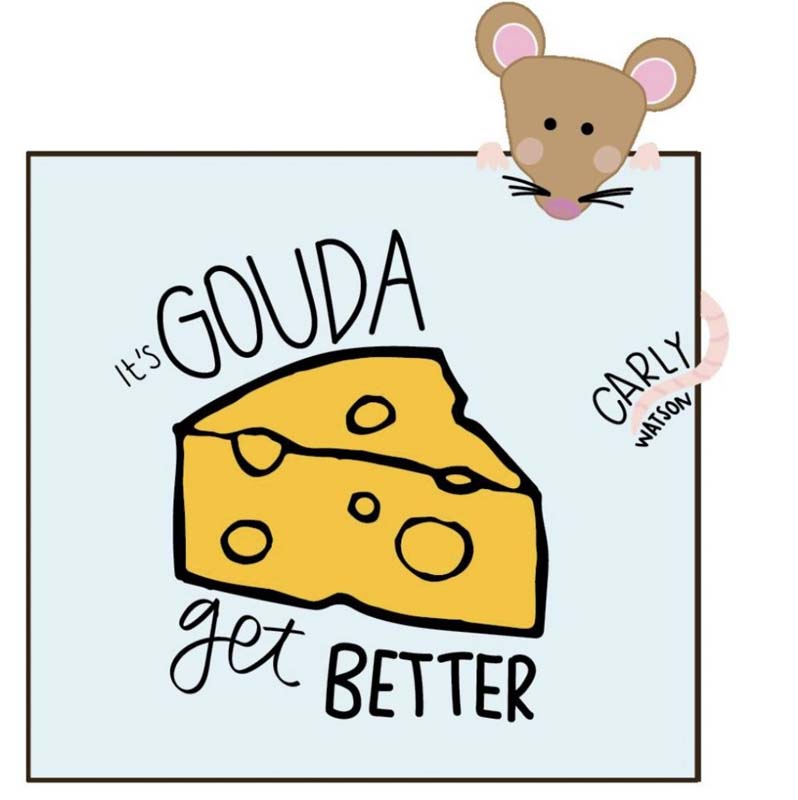
It’s Gouda Get Better
If you prefer to read my story, or follow along as you listen, it is posted below.
It’s Gouda Get Better
His small nose twitched as the rich aroma of Swiss cheese filled his knot hole. Ricotta, or Ricki as everyone called him, rubbed his eyes and swung himself out of bed. He shivered. A cold draft that he was not used to made him pull out his winter sweater. After he fed his pet rolly-pollies, Colby and Jack, and brushed his whiskers, he sat down to have some of the cheese he had been looking forward to all week. Now this was no ordinary Swiss cheese. He had gotten it from his best friend Goldie for his birthday, and it had been freshly imported from Cottage Court. Just as he was about to take a bite, he heard some commotion coming from the town square. I do hope everyone’s alright, he thought as he rushed to the window to see what was causing such a ruckus so early in the morning. He immediately noticed that his friend Goldie had her head drooped. This surprised him, as Goldie was the happiest soul he had ever met. Every morning, the town would gather around her, and she would generously sprinkle her tasty seeds over the mice families. Her smile shone brighter than the sun itself, and her velvety petals were softer than pillows. But today, as fall leaves fell around her, and the sun was nowhere in sight, her sun was gone too. He noticed the pockets—the places where each of her seeds had lived—were now empty. She had no more seeds to give to the mice down below who fought angrily over the remaining few. Ricki watched in horror, stunned, as the mice’s anger turned from each other to Goldie. They shook their tiny fists and began to circle around her like wild animals about to pounce on their prey. Her already large eyes magnified as they filled with tears, and the huge drops splashed the mice. Their shouts grew louder and louder as Ricki struggled to pull on his trousers and red rain boots and dash outside. “Stop!” he shouted, but no one heard, or no one cared to hear such a small mouse in such a large crowd. The mice began to close in on the sunflower as Ricki desperately tried to push himself through the crowd to reach her, but he was too late. He heard the sharp sound of teeth chewing away. Once he was close enough to see, he wished he never had. White teeth kept gnawing away, angry and determined. The other mice chanted, their fists raised in the air. A loud creak, then a snap, and Goldie came crashing down all together, her face up to the sun. Her huge eyes slowly closed for the last time. The town square quickly cleared, each mouse suddenly with somewhere to go and something to do. Ricki tentatively approached Goldie, paws outstretched. At first, he just cried into her petals, until no more tears came. After he had blown his nose on a nearby leaf, even though her petal would have been much softer, he looked up. As he did, he noticed that one final seed was wedged in one of her pockets. He gently loosened it, careful not to tear any of the surroundings. He tenderly tucked the seed into his trousers pocket, and scurried home, leaving a salty river of tears behind him. Working quickly, he found a small acorn cap and began using it as a shovel, digging faster and more vigorously than he had in his whole life. His ears were filled with the sound of his own heartbeat. After carefully watering the hole he had just dug (even though his tears had already sufficiently watered it), he pulled out the seed, and gently lowered it into the earth. He patted it down, wiped his paws on his pants, and stroked his whiskers, sighing. Something was missing. He ran inside, and paws shaking, brought out the hunk of Swiss cheese. He laid his beloved birthday gift on the fresh patch of dirt. Intention Statement: It’s Gouda Get Better is a flash fiction story about loving and caring for others even when they do not have anything left to give you. Inspired by the fable The Old Hound, written by the Greek author, Aesop, this story is supposed to give the reader a chance to think about how they treat those who are unable to give them anything in return. In The Old Hound, a hunter takes his loyal dog out to catch some game, only to realize that despite the dog’s efforts, he was getting too old to hunt. The owner beat his dog, and the dog sadly realized that even though he had given everything he had, now that he could not give anymore, he was no use to his owner. In my story, Goldie the sunflower represents the Old Hound, and the village mice represent the hunter. However, I refused to believe that everyone is like the hunter, so I wrote the character of Ricki, who represents those who help, expecting nothing in return. In terms of subtext, I used the changing of the seasons and him shivering in the beginning to help foreshadow that like the outside world, his world was getting colder too. I added the details about his pets, the boots, and his thoughts to show how sensitive and sweet he is. Another example of this would be when he chooses to blow his nose on a leave instead of on a soft petal to show respect and reverence. I chose to write in third person because I wanted to maintain an objective, matter-of-fact point of view. One reason that I chose to do this was because I was trying to write this story more like a children’s book, which is usually in third person and relatively straightforward. In the end, I chose not to fully restore everything, but to leave the reader visualizing a scene of hope, where Goldie still lived on through her seed. They were also left with the image of Ricki, who had experienced hardship, but was still caring and kind. During my peer review sessions, my readers enjoyed how much they liked the protagonist, and how much they were immediately put in the scene. I did, however, get the feedback that some phrases and word choices were repetitive, and that I should introduce all of my characters sooner. I applied this feedback by adding a variety of phrases and descriptions, and by introducing both of my protagonists in the first paragraph. Even though the moral of the story was based on the Old Hound, I also drew inspiration from The Flowers by Alice Walker, as her character was carefree and innocent at the beginning of her story, but through a painful experience grew and learned something new about the world.
For our English final, I wrote a story trying to emulate George Saunder’s writing style inspired by the true story of a plane crashing in my neighbor’s yard. I enjoyed the freedom we had to write what we wanted, and I used that opportunity to try and write in a style that I had never tried out- and one that was drastically different from my previous story. Below is the presentation that I gave for my final with a sample of my writing at the end.
The Not-So-Old Old Lady
By Carly Watson
The Not-So-Old Old Lady By Carly Watson The old lady still reminds me of the story every day. I do not know her name, and it seems much too late to ask. She has been my neighbor for over 55 years, and come to think of it, she could start referring to me as an old lady quite soon. Every morning when I go to get the paper, she waits for me, the water from her watercan dripping onto her slippers, her curlers falling out, and her robe covered in cat hair. In many ways, she is still the same woman she was back then. She used to have a kitchen full of cookies, and I would come over after school to have some. With me smiling and sitting in her lap, she would urge me to have another another another. She would lay in her hammock, rain or shine (or even hail once), and read each afternoon. Her garden was filled with roses, and you could hear her holler every time she pricked her finger. My mother would roll her eyes, but I would run out with a bandage. She would gratefully accept, dramatically wrap the bandage around her finger, and come out with another plate of cookies. One time, I ate so many cookies that I could barely eat a bite of dinner. My mom scolded me, and forbade me from taking more cookies from her. Then, in a moment of what I considered pure cruelty, she forbade me to go to her house at all. She told me it was time to make friends my own age. One day, when my mother was away, I slipped over to her house. Her cats greeted me at the door, and she ushered me into her kitchen. I had never seen so many cookies before. Mounds and mounds were stacked up on plates, in bowls, in the fridge, and the cupboards. A timer went off, indicating that another batch was done. The old lady, who was not very old at the time, but already acted like it, wept with joy that I had returned. She thought I had abandoned her. I indulged and ate a few too many cookies that afternoon, but made sure to make it back before my mom came home. I even forced myself to eat seconds at dinner so as to not cause any suspicion. Soon, it became a routine to sneak over to her house. I even started sneaking over when my mother was home. I began to become more and more confident, telling my mother extravagant lies. I am going to the library, or I am going to go on a run. My personal favorite- I have a friend to go hang out with. My mom, eager to believe what she heard, would let me go. And so I went, everyday after school. Until one day, on a Monday, I had a terrible headache and could not get out of bed. I tossed and turned, and I thought of the old lady and how sad she would be that I did not come to visit. I looked up as I heard a tap tap tap on my door to the backyard. It was her. The old lady, with a plate full of my favorite, chocolate chip. I signaled for her to be quiet, and forced myself out of bed to slide open the door. She clambered in, her slippers leaving muddy footprints on my rug. I was too pleased to care. And that day, as she was hiding beside my bed, whispering to me of her childhood, pulling a blanket over her face when she heard footsteps, that day, she tells me I saved her life. I fell asleep, my head still pounding. I kept fading in and out of a dream. In it, was back on a plane to Hawaii, the place we took our annual family trip. I’m not sure when, but she finally had to go- the cats needed to be fed she said. She was met by a great surprise. A jet had crashed in her backyard. Lawn flamingos, chairs, a metal table, and the very hammock she would have laid in that afternoon, were crushed under the gleaming silver body of the jet. She said that police, firemen, and what seemed to be the whole neighborhood were crowded around her house, trying to find her. The plane was too heavy to move, and they feared she had been crushed too. Each time, she laughs, recounting how my mom had paced, up down up down up down the sidewalk. The old lady, thinking fast, began to walk towards them, pretending her cat had been lost. Relieved to see that she was alive, but still hating everything about the not-so-old old lady, my mom went back to our house. After hours of restless dreams filled with sirens, hums, and muffled shouts, I was awoken by the old lady shaking me so hard that my brain rattled against my skull. After the police had packed up for the day, she had come to tell me all about it. Hands shaking, she had placed a small piece of one of the plane’s broken windows into my palm. She kept shaking as she muttered about me saving her life, thank you thank you thank you. When she heard my mother call me to see if I was well enough to have dinner, she slipped out the door. That night at dinner, I had to pretend to be shocked as my mom told me about the jet that had crashed in our neighbor’s yard, and how lucky that neighbor was that her pesky old cat had gotten away, and so she had to look for it. Otherwise, that poor madwoman might have been crushed. And what a shame that would have been. And did I even remember the crazy lady from next door? The one I used to eat cookies from when I was young and friendless? I squeezed the glass tighter in my palm, and I stayed quiet, staring. That night, my mom noticed the mud prints and asked about them. I shoved the half-eaten plate of cookies further beneath the bed with my shoe. Then I told her that a friend had to go through the window because no one had been in the house to answer the door. And that was the truth.

Illustrations
For Digital Media, we were able to take everything we had learned in Illustrator and pour it into a project of our choice. It was so exciting and fun to see an idea get transformed into a real, tangible item. In the end, I decided to make a night light for my friend and some stickers. One of my favorite things I got to do was make custom brushes, which I show below in the Illustrator process images.
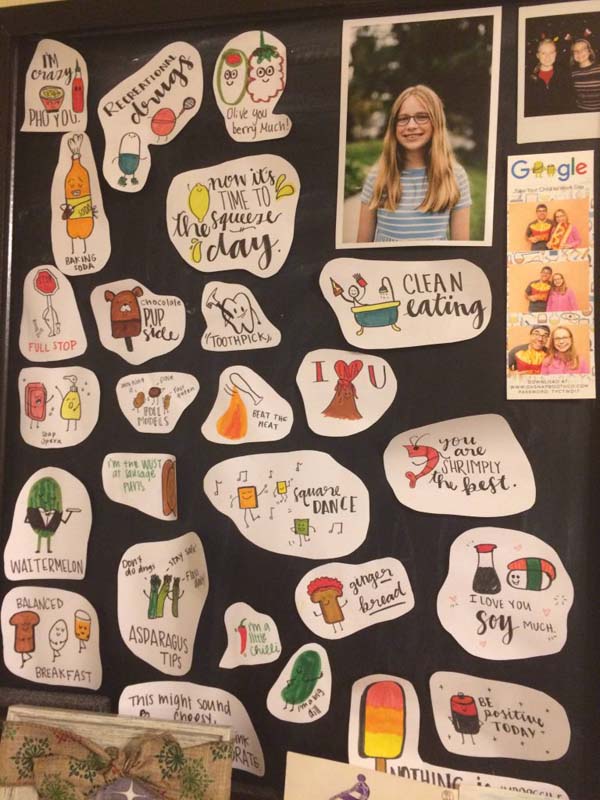
Inspiration for my Stickers 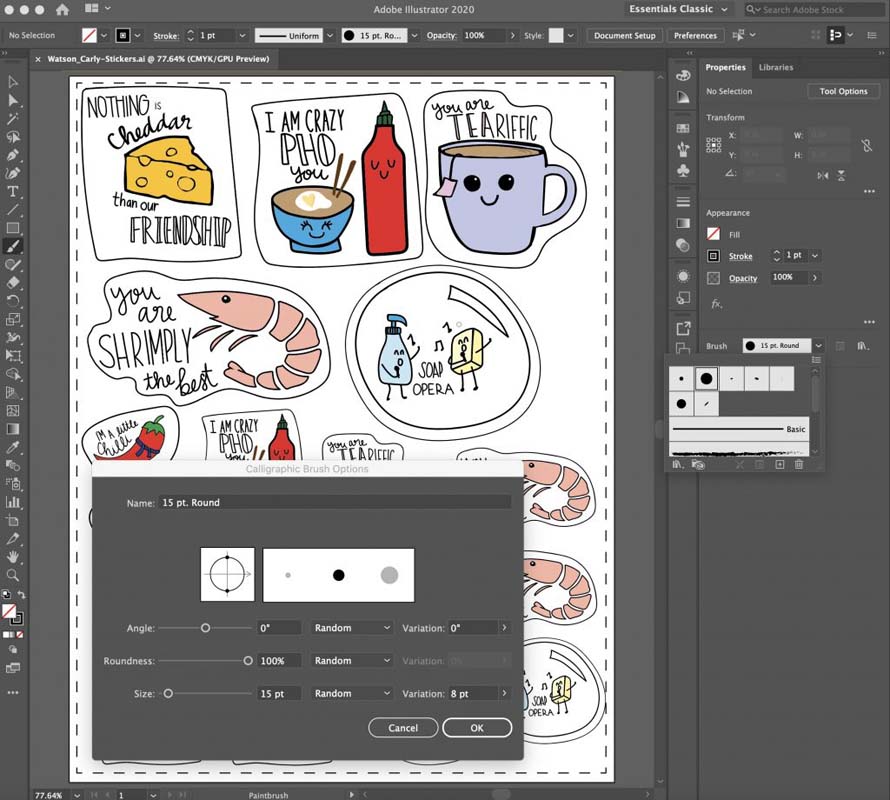
Making the Stickers in Illustrator 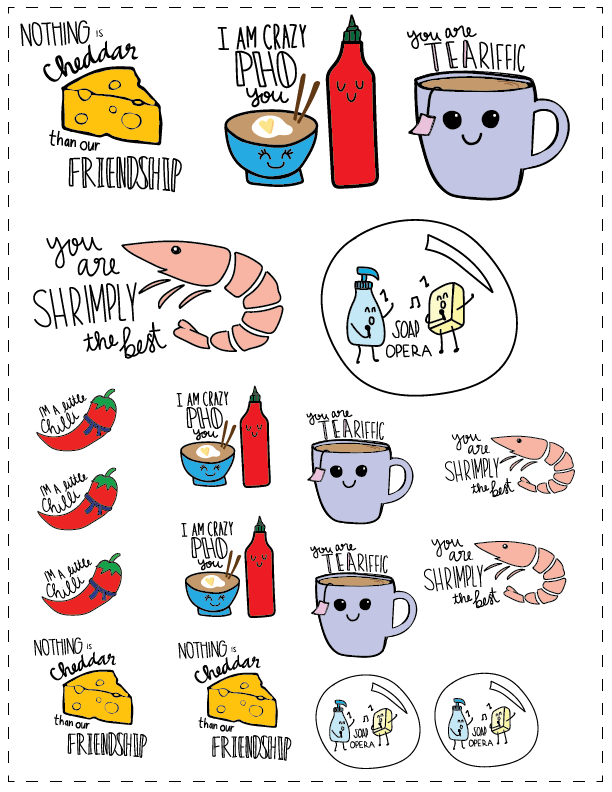
Digital File of Stickers
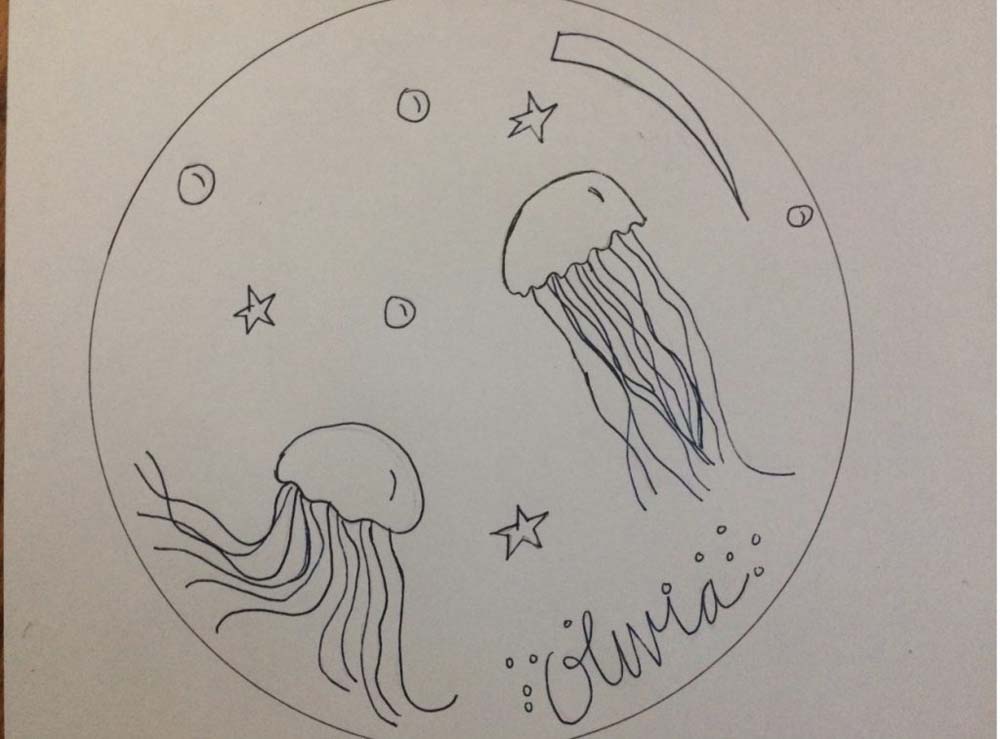
Original Sketch 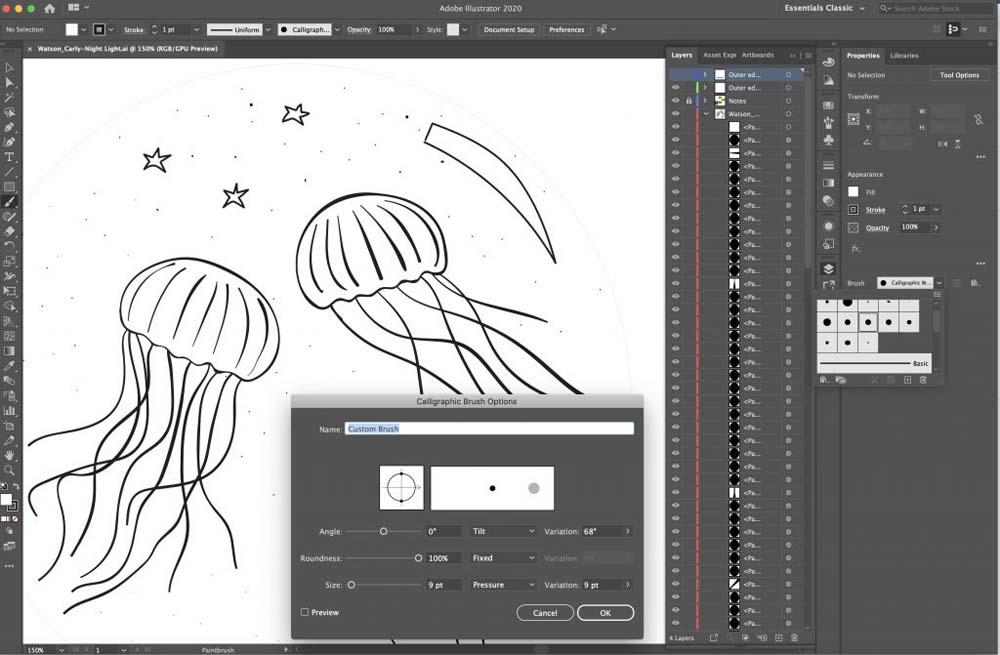
Making File in Illustrator 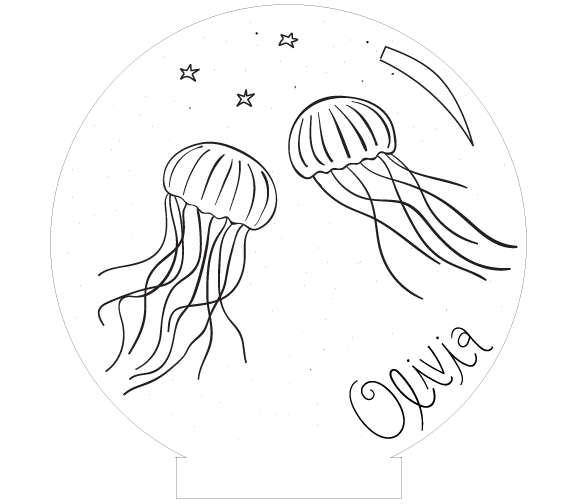
Digital File
I love listening to music while I create. This time around, while making my Jellyfish light, I listened a lot to “Olivia” by One Direction. (Partly because it is a great song, but mostly because it was really awesome to listen to a song called Olivia while I was making something for my friend named Olivia.)
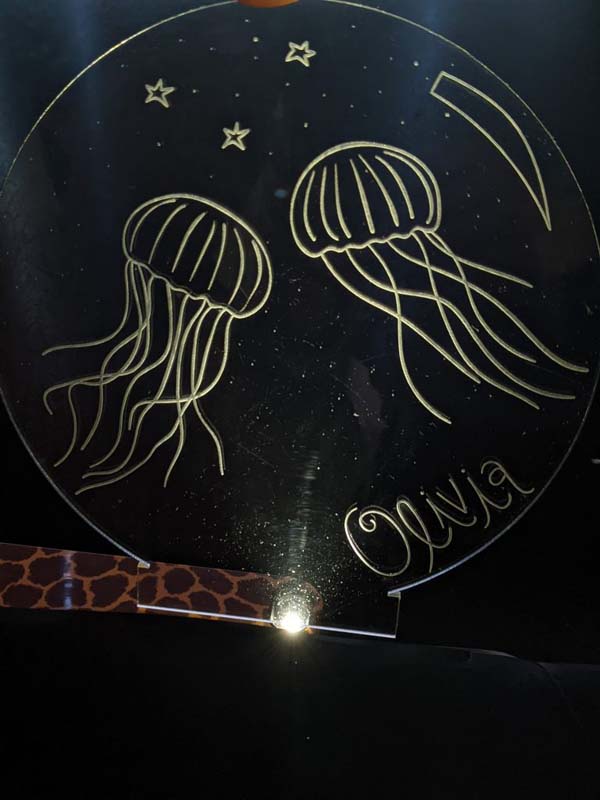
Final Result of Jellyfish Lamp 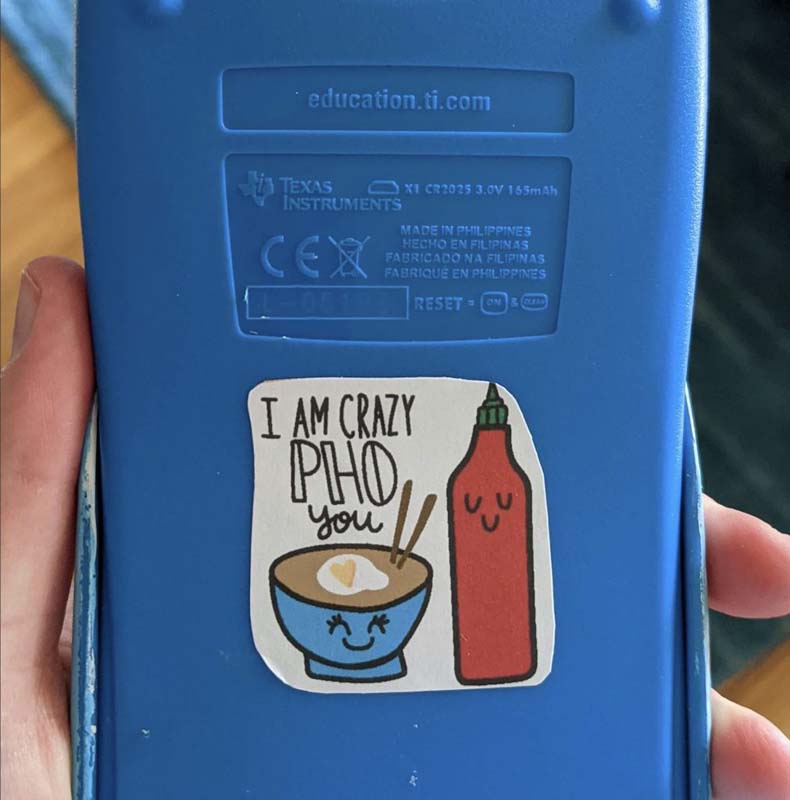
Final Result of one of my Stickers
Of course, no art piece would be complete without an artist statement! Read below to discover my journey in making these pieces.
Statement for Stickers- These Stickers are Shrimply Amazing Back in middle school, puns were one of my favorite things. I used to draw little puns on random scraps of paper, practice my calligraphy, and make them as cute as I could. I had multiple “pun boards” that decorated my room. Since then, I have chosen my favorites and condensed all of them into one pun board, but I still enjoy seeing them. I was inspired by these silly puns for my stickers because I thought it would be super cool to see my cute pun doodles look a little more professional and be in a sticker- something I could give to friends and family! Even though I did struggle with learning how to work with Illustrator, I soon grew to love it and the freedom it gave me. I also learned that it is not worth it to take short cuts- they will come back to make your life much harder in the long run! It was so much more efficient to learn how to do things the right way. I am now harnessed with a greater appreciation for artists who put in so much time and effort into their art, a greater knowledge of how to use tools, and more ideas with stickers I could create in the future. Statement for Night Light- Bubble of Bliss (and Jellyfish) One of my best friends, Olivia is moving off to college this year. I really wanted to give her something meaningful that could not only be cute, but also useful and show her how much I love our friendship. When I heard that night lights were an option for this project, I knew that is what I wanted to make for her! I went for a whimsical jellyfish look, and included her name as a personal touch. This was extra special because she is the one that taught me how to do calligraphy and a lot of other art projects. I found it hard to make my jellyfish even, and they did not look quite right for a long time. Eventually, I decided to test out some different brushes, and ended up experimenting with making my own brush in Illustrator. Even though it required a lot of trial and error, I was able to have something I was happy with in the end. I learned how important it is to give yourself the time and space to be creative and if you do that, you will be able to make something that you love.

Music Production
We used ProTools to learn how to edit and make music and soundtracks, something I had never tried before. We made music mash-ups, played around with sound effects, learned how to make audio sound a specific way, and how to piece it all together. To use all of these skills in a single project, we were challenged to write and edit a parody. I chose to write “Corona De Vil” and sing it to the tune of “Cruella De Vil.”
The inspiration for this song came at the beginning of quarantine during dinner, and before we knew it, my entire family was jumping to write another line of the song. It was so much fun to work together! Although there were many drafts, we needed with something that we were all happy with.
Since this soundtrack has very few instruments, it was a huge challenge to try and strip away the vocals and leave the instrumental soundtrack- because there was such little left. I also added reverb and normalization to the final product to make it sound more like a studio. Overall, it was a great learning experience and a lot of fun. I would encourage you to give it a listen below. The lyrics are also posted on below on top of my ProTools session workspace.
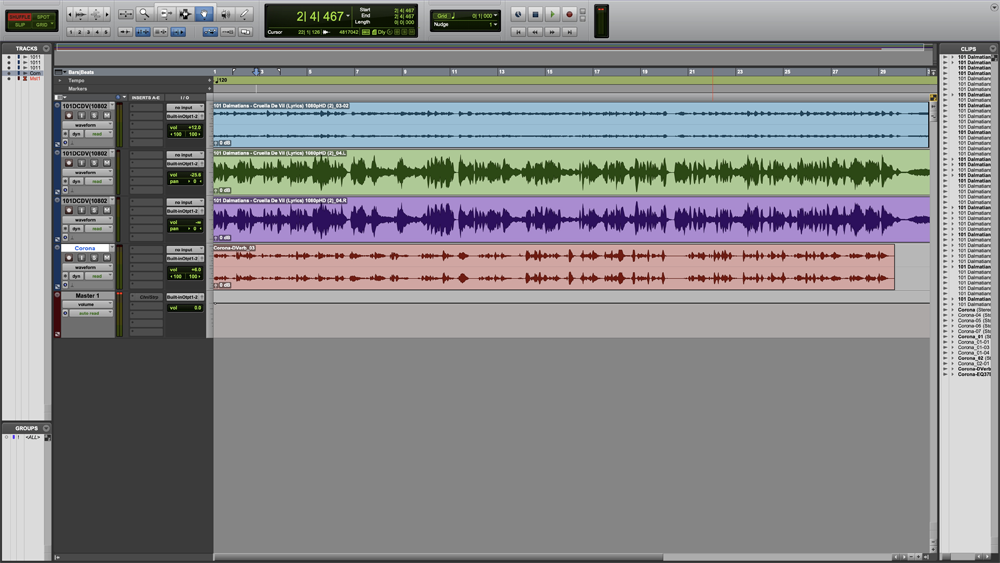
Lyrics:
Corona De Vil
Corona De Vil
If it doesn’t scare you, then no virus will….
It’ll give you fevers, and the chilllss
Corona,
Corona,
There’s no vaccine
Let alone a pill…
At first, you think corona’s influenza,
But after time has worn away the cough
You come to realize
Through your bleary eyes, that you definitely shouldn’t scoff…
You better wear a mask, and shelter in place
Until it can be locked up, nobody is safe
The world was such a healthy place until…
Corona,
Corona,
De Vil

Storytelling Through Film
In my elective class- Film, we learned how to tell a great story from start to finish. The story is the most important part of a film, we learned. No matter how good the shots, the lighting, or the sound, with a lame story, the film will be just that. With this in mind, we got right to work on learning what made a good story, well, good.
In order for a story to be meaningful, you need to get your audience to buy into the film and suspend reality for a while. They need to be investing in your character. The best way to do this is by making your character relatable, and by having your character grow and change (and go through hardship) throughout the course of your film. This gives your audience something to root for.
We started by watching a lot of short films and analyzing what made them effective, what kind of story they told, the three-act structure, and patterns. Over time, we were able to start and recognize what we liked and why we liked it. Mr. Taylor, my teacher reminds us constantly that we understand film as a language, we just need to learn how to speak it.
It was time to start.
We began by practicing different exercises to help train us to see patterns and use our equipment effectively. We did three main ones, each with different groups: A Suspense Scene, A Chase Scene, and A Griffith’s Pattern Scene.
For our Suspense scene, we learned many tools, such as music, pacing, and cross-cutting to build suspense and tension. Below I have a video displaying these things:
Using “Back to the Future” as our guide, we learned how to make a thrilling, exciting, (but logical) chase scene. We had to understand how to orient our audience, how to get them invested, and which rules (like the 180 degree rule) to follow. My sisters were nice to help act in my scene, and you can enjoy it below:
Another technique to get the audience to understand what is going on is to use Griffith’s Pattern- where things are shown from far away, closer, and then even closer. An example of this would be to show the exterior of the house, then the house’s door, and then inside the house. Without the camera going through the door, it still is apparent where the film takes place. Below is the example that my group and I made:
To start the process of coming up with a story, it is always helpful to get all of your ideas down and out of your head. This is what I created just as the idea was still forming and my thoughts were still jumbled:
Meta Film “Oh, Shoot” Main characters: 2 friends (tweens or so) have a want to enter a contest to make a film. They go around the neighborhood/call people and ask them to be their actors. All refuse/can’t/won’t do it for one reason or another. They try so hard, and almost give up, but then they look out the window and see their neighbors, and an idea comes to mind… So they decide to set up pranks/reasons for the random people they need to do what they need them to do as their actor. For example, if they need someone to bend down and look angry, they might leave a pile of dog poop on their neighbor’s lawn, have them bend down to pick it up, and look upset. They hide in the bushes and film it, etc. Another one could be that they need someone to look happy so they leave flowers, they need someone to be confused so they wear something stupid while they are driving etc. They work really hard to edit the film in time for the contest.. And they get to show it at exhibition (yay!) On the big night, they look back, and see their neighbor (don don don) or something like that.
Next, comes a shot list. This is an example section from mine and my partners (there are over 115 shots on our list). Making this list helped us sort out our ideas and be on the same page. It also helped us understand what we would do when we started shooting.
1. Shot of hand picking up pencil 2. Over the shoulder-ish of her beginning to write a note (heart shaped), tosses note aside 3. Kid leaves room with note and camera 4. Shown walking in house 5. Grabs flowers from vase 6. Shown leaving the house (shot from outside) 7. The kid is in the bushes, with their tripod, adjusting the camera. 8. Shot of the kid leaving the flowers on the porch 9. Close up of the flowers on porch 10. Ringing the doorbell
Next came the storyboarding. This means drawing out every shot to really visualize the film. We had originally made a film about angry neighbors during Christmas. Below is the storyboard for that. Storyboarding the film allowed us to realize how many holes and problems there were in our film, which encouraged us to either revise or switch ideas (we switched).
There were so many details that we had not considered when we first thought about our idea. So many little things – outfit changes, props, hair, the list went on and on. One fun thing we got to do for our film was design flyers. We tried to make them look legit, and it was fun to see something we designed in our film!
After numerous shots, lots and lots of Zoom planning meetings, late night editing sessions, intensive color-grading, projecting-illusions, mulling over thousands of different royalty-free songs and adding the final touches, our film was complete!
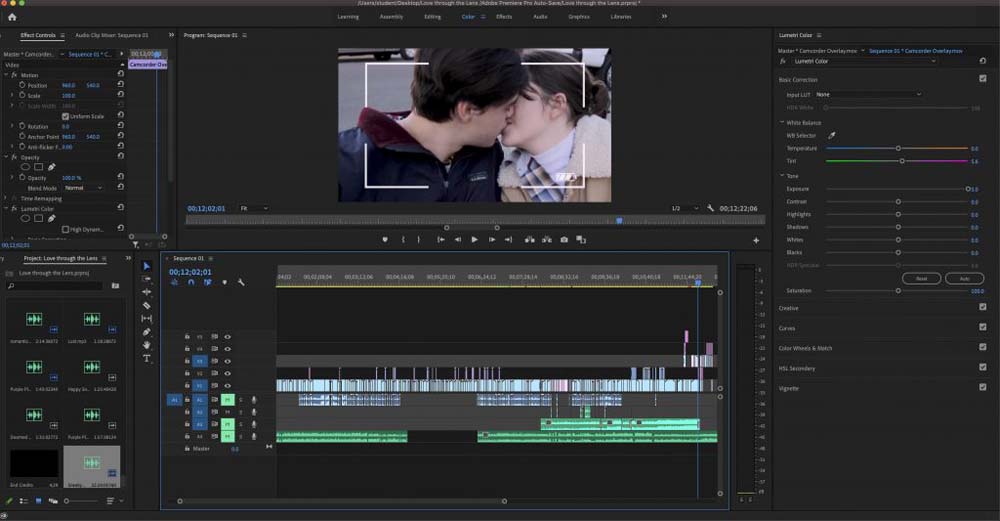
Presenting… Love through the Lens:
If you were hooked by the trailer, why not stick around and watch the entire film?
…. The End …. (or is it?)

